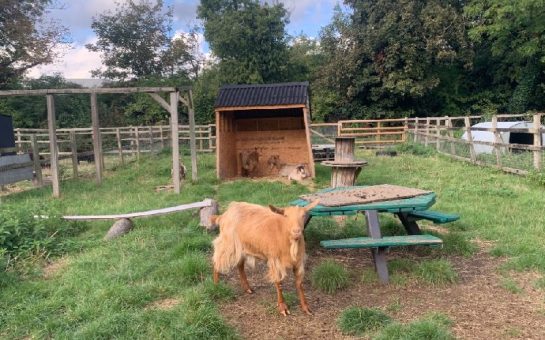Spedeworth motor sports has had a residency at the stadium since 1962.

For the neighbourhoods around Plough Lane, Sunday evenings in the winter months are not the most peaceful. A steady drone, the sound of straining motors, emanates from Wimbledon Greyhound Stadium.
It’s not only dogs that race there. Spedeworth motor sports has had a residency at the stadium since 1962, and as the days get darker earlier, it becomes home once more to a series of championship races: stock-cars, bangers, stock-rods, an assortment of cars from purpose-built racers to MOT-failures destined for the scrapheap.
Stock-cars, like greyhounds, race around an oval track, and they too will be put out of their London base if AFC Wimbledon wins their bid to redevelop the Plough Lane site.
Nick Hughes, a spokesman for Spedeworth, doubts that stock-car racing will find another London home if that happens. However, Paschal Taggart, the Irish businessman proposing a £40m rebuilding of the stadium, has been in talks with Spedeworth about incorporating a stock-car track into his ‘Olympic’ vision.
Mr Hughes said: “The problem we see is that the local council have never made a secret of the fact that they would love to have the football club back in the borough, so that option would appear to be the favoured one. “
Scepticism lies around the impartiality of Merton Council. ‘We Want Wimbledon’ (WWW), Taggart’s campaign group, recently lodged a formal complaint to Secretary of State, Eric Pickles, which the council have refuted vigorously.
Suggestions made by Councillor Stephen Alambritis that the site could be shared have been dismissed by the group. Diane McClean, a spokesperson from WWW, said that it would be impossible, due to the time needed to clear the stadium between a match and a race.
She raised concerns too about the financial viability of the idea: “As Mr Taggart has experienced, football teams are not the most reliable lessees and it is often the case that they cannot pay their way in such a shared development.”
Taggart’s finances were made available to Merton Council in March 2013, but WWW raised concerns about whether AFC Wimbledon’s £16million fundraising bid was a solid one.
Ms McClean said: “However, can the same be said about AFC’s financial details given their ‘financial deliverability’ relies on a future promise and fundraising and appear to be more aspirational than real?”
Those who remember Wimbledon Stadium at its prime are despairing about the disrepair it has fallen into. Sunday’s British Championship had an audience of less than 500, although Deane Wood, the owner of Spedeworth, recalls a time when stock-car racing would draw crowds of 30,000 to Plough Lane.
The races, anarchic to watch, are closer to large-scale dodgems than professional motor-sports such as Formula One, but the car park where drivers and their families assemble beforehand is friendly. Children help out with the mechanics, or pose for pictures in the cars.
Mr Wood suggested that the owners of the stadium have been trying to run it into the ground in the hope it will be taken off their hands, ready for demolition.
“Look at it,” he said, gesturing to squashed fruit, left over from the market earlier that day. “Would you want to bring your kids here?”
Gentrification of the stadium is something that Mr Wood said would draw in more people, who could enjoy more than a good race. His vision is one of restaurants with waiters, and leather seats where people can watch from, rather than the burger stand and fold down plastic seats that spectators use.
Nick Hughes agrees. “We can only hope that Paschal gets a fair crack of the whip when it comes down to what the future use of the stadium is going to be when it comes to the planning stage,” he said.
Sunday October 20 was the stock-car British Championship, won by Adam O’Dell, 19, who races alongside his dad Steve, and brother, Dean. All three drive cars bearing the name O’DELL painted across the roof, a co-ordinated effort in red, white and blue stripes that marks them out as a family.
The sport may get little to no recognition in the press, but the cars are beloved by their owners and painted in great detail, armoured according to the skill and whim of their driver. Requirements are that the car must have a 1300CC engine, and no windows, so that if the car rolls over, the driver can climb out with ease – an audience favourite.
Steve O’Dell, 48, said that for all its faults the Plough Lane stadium is unique from any other race-track in his 33-year experience of motor-sports. He compared driving from the pit through a tunnel and into the arena is an experience that feels akin to walking out onto the pitch at Wembley, and one that is uncommon in Spedeworth’s other sites.
Unlike the newer tracks that Deane Wood has over-seen, Wimbledon has fallen behind with standards: only a thick wire fence separates the cars from the crowd, and sparks fly each time a car pummels into it.
Paschal Taggart’s plans would see a more standardised model, with concrete safety barriers installed, and the audience elevated above the track.
For those involved in stock-car racing, it is a sport that is constantly changing, from the technology of the cars and equipment used. Many cars are now fitted with US standard racing seats which support the driver’s neck and ribs should the car overturn.
Nick Hughes saw his first stock-car race at Wimbledon Stadium in 1982, and says that the sport has transformed drastically since then. “The popularity has probably declined since the 70s and 80s when it was at its prime,” he said.
Despite the fall in attendance, the DIY nature of stock-car racing has kept its devotees. Although Wimbledon is the last London stadium still used by Spedeworth, Mr Hughes said that amateur motor sports will retain their popularity.
“There is always likely to be a role as we operate at the more ‘budget’ scale of racing for those who don’t have the big money sponsors behind their racing paying for tyres, engines, and repair work,” he said.
Yet he is stoical about the future of Spedeworth if stock-cars and their drivers do get forced out of SW19.
“Stock car racing will continue in the UK but such is the history and tradition of the Wimbledon Stadium venue that it will leave a gaping hole in the sport,” he said.
“I can see that it would be desirable for AFC Wimbledon to be playing in the borough, but the original football club gave up their original site just up the road in Plough Lane for housing so should have no divine right to come back as far as we are concerned.”
Photo courtesy of Chris Turner Photography, with thanks.
Follow us @SW_Londoner




